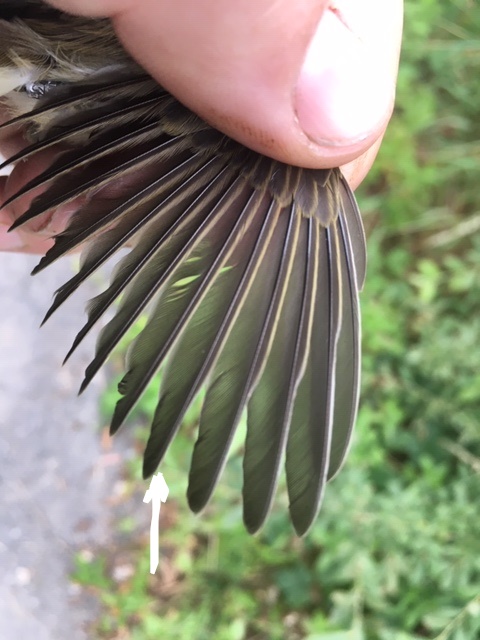It was apparent that migration was under way when we ended at 10 am with 127 new birds ringed of which 101 were migrant warblers. Blackcap were the most numerous ( as they will probably continue to be from now on) with 35, Chiffchaff 21, Reed Warbler 15, Sedge Warbler 12, Willow Warbler 9, Garden Warbler 8 (!!!), and Common Whitethroat 1. In total we ringed 16 different species of birds--on top of which many of those present had their first ever view of a Water Shrew :-
This tiny shrew spent quite some time snuffling about in the vegetation beside the path eating insects before disappearing down into the ditch next to the path.
Birders often agonise over the separation of Willow Warbler and Chiffchaff--especially if they don't sing or call. Fortunately these species are relatively easy to identify in the hand--but the way we do it isn't too helpful in the field unfortunately. It's all about the shape of primary wing feather number 6.
The feather arrowed is primary 6 and in this picture you can see the outer web slopes in towards the shaft of the feather towards the tip--called 'emargination'. This is a CHIFFCHAFF wing.
Primary 6 on this wing has no emargination ( primary 5 has) so this is a WILLOW WARBLER.
Best of luck spotting this in the field!!
Exceptionally, some species ( for a reason I'm not aware of) adults and juveniles go through a complete moult of body, wing and tail feathers about this time of year. Long Tailed Tit is one such species. Once they have completed this moult its impossible to age this species--but just at the moment they are in the process of moulting and there are still clues as to whether birds are adult or juvenile--as shown in these two birds:-
Looking at the wings you can see that there are gaps and growing feathers where the wing feathers are actively moulting. However, if we look at the heads of the two birds:-
--you can just about make out that the top bird has brown feathers on the sides of the head showing it to be juvenile, and the bottom bird has black sides to the head-an adult. In a couple of weeks they will both look the same and unable to be aged by conventional methods.
It looks like the weather pattern may well be against us on Saturday with a possible wet period in the morning--I will post any change to our schedule on here.





No comments:
Post a Comment